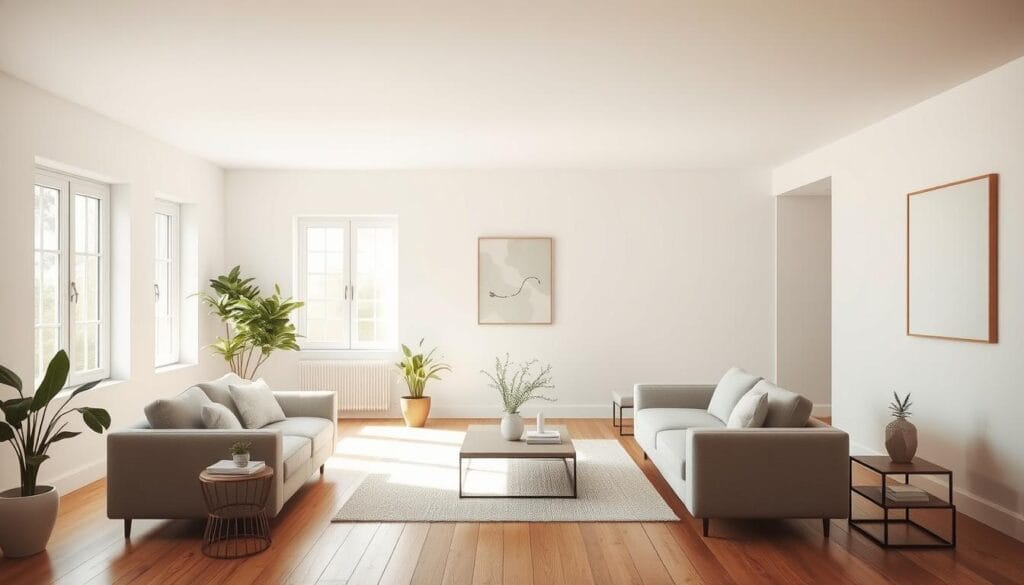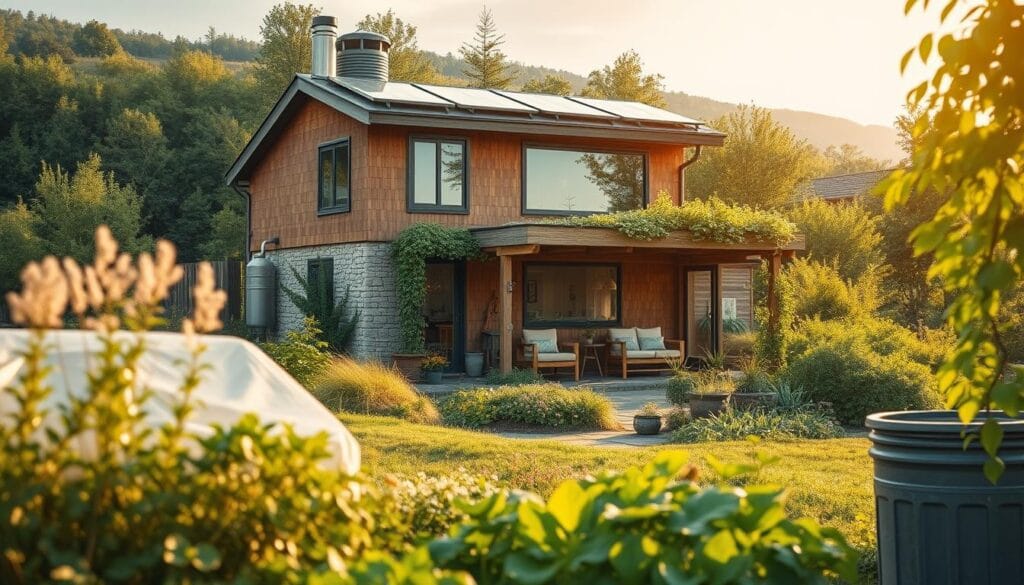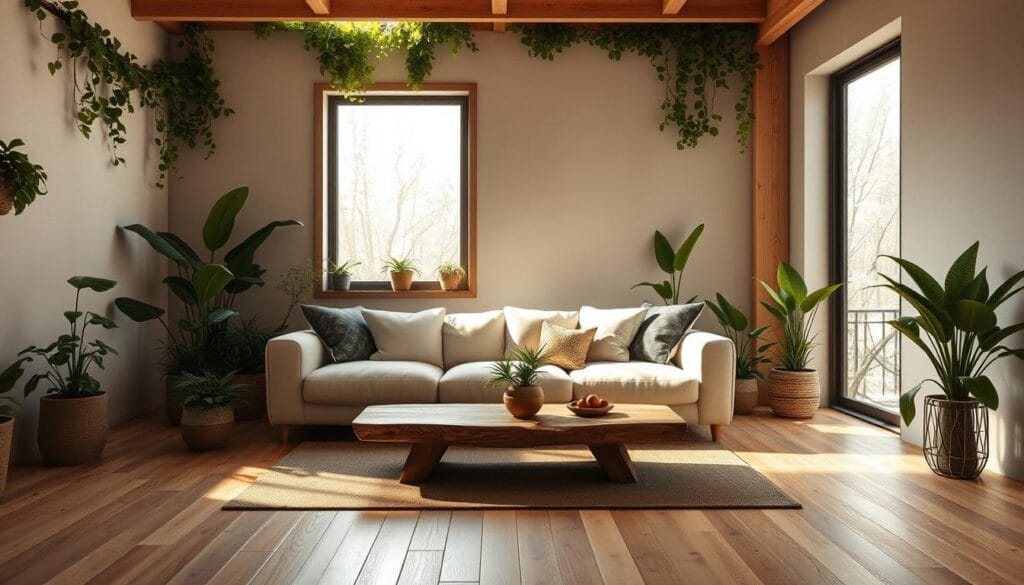Have you ever walked into your home and felt overwhelmed by the sheer amount of stuff around you? You’re not alone. Many of us live in spaces filled with items we rarely use, yet they take up valuable space and add unnecessary stress to our lives. The good news? There’s a better way to live.
By embracing a simpler approach, you can transform your living environment into a peaceful sanctuary. Decluttering isn’t just about tossing things out—it’s about making intentional choices that bring value to your life. When you focus on what truly matters, you’ll find more time, energy, and clarity in your day-to-day routine.
This journey isn’t just about your personal well-being; it’s also about caring for the environment. Reducing waste and choosing eco-friendly products can significantly lower your carbon footprint. Together, we can create a lifestyle that benefits both you and the planet.
Ready to take the first step? Let’s explore how a clutter-free, sustainable home can simplify your life and bring you peace. Learn more about this transformative approach.
Starting Your Sustainable Decluttering Journey
Ever feel like your space is working against you? You’re not alone. Many of us live in homes filled with items we don’t need, creating unnecessary stress and chaos. But here’s the good news: decluttering can be a transformative experience—not just for your home, but for your life and the planet.
Understanding Your “Why” and Motivation
Before diving in, it’s important to ask yourself: Why do I want to simplify my life? Your answer might be personal, like reducing stress, or practical, like creating more room for the things you love. Whatever your reason, it’s the foundation of your journey.
Decluttering isn’t just about tossing things out. It’s about making intentional choices that align with your values. When you focus on what truly matters, you’ll find more time, energy, and clarity in your day-to-day routine.
“Every small step you take toward decluttering is a step toward a more sustainable lifestyle.”
Assessing Your Current Space and Needs
Start by taking a honest look at your home. Walk through each room, open every drawer, and examine every shelf. Ask yourself: Do I really need this item? If the answer is no, consider donating, repurposing, or recycling it.
Creating a personalized decluttering checklist can help you stay organized. Focus on areas that cause the most stress, like cluttered countertops or overflowing closets. Remember, this is your journey—take it one step at a time.
By connecting your everyday choices to a broader environmental benefit, you’re not just simplifying your life—you’re making a positive impact on the planet. For more inspiration, check out these organic modern living room ideas to create a space that feels both functional and inviting.
Mindful Minimalism: Creating a Clutter-Free and Sustainable Home
Does your space feel chaotic and overwhelming? You’re not alone. Many of us struggle with clutter that takes up valuable room and adds stress to our lives. The good news? There’s a simple way to reclaim your home and make it work for you.
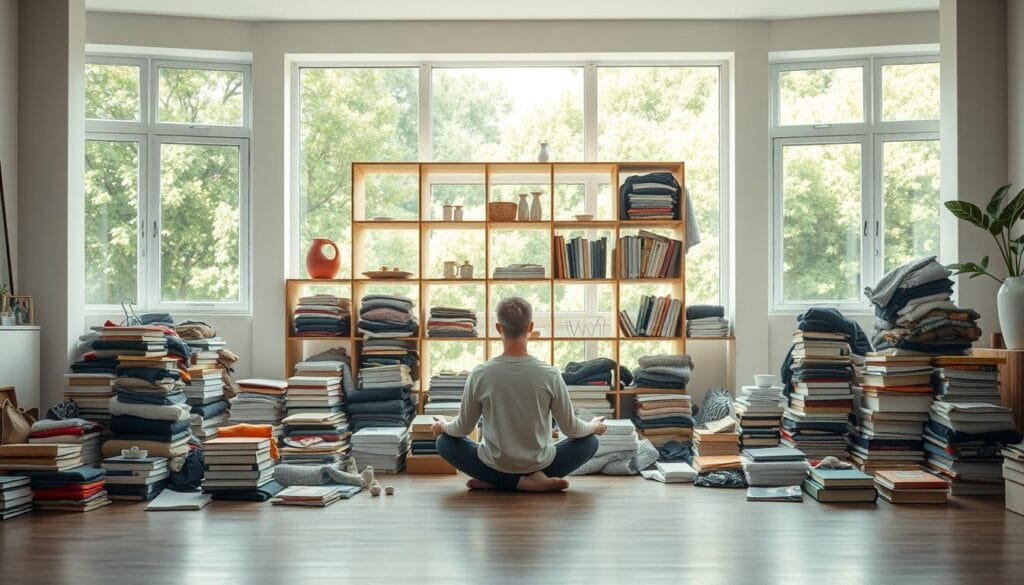
Practical Decluttering Techniques
Start by sorting your items into four piles: keep, donate, recycle, and repurpose. This method helps you focus on what you truly need. For example, old T-shirts can become cleaning cloths, reducing waste and saving money.
Here’s a quick guide to get started:
- Keep: Items you use regularly or love.
- Donate: Things in good condition that others can use.
- Recycle: Materials like paper, plastic, or glass.
- Repurpose: Give old items a new life.
Choosing Eco-Friendly Alternatives
When it’s time to replace products, opt for sustainable options. Bamboo is a great alternative—it’s renewable and durable. Recycled goods also help lower your carbon footprint.
Here are a few swaps to consider:
- Use bamboo toothbrushes instead of plastic ones.
- Switch to reusable cleaning cloths instead of paper towels.
- Choose glass or metal containers over plastic.
Building a Routine for Consistency
To maintain a clutter-free lifestyle, establish a simple routine. The “one in, one out” rule is a game-changer. For every new item you bring in, let go of something you no longer use.
Set aside a few minutes each day for cleaning and organizing. Small, consistent efforts lead to big progress over time. Remember, this is a journey, not a race.
“Every small step you take toward decluttering is a step toward a more sustainable lifestyle.”
By following these steps, you’ll not only simplify your life but also make a positive impact on the environment. Ready to start? Your peaceful, clutter-free home awaits!
Integrating Eco-Friendly Practices into Every Room
Transforming your home into an eco-friendly haven is easier than you think. Small changes in your daily routine can make a big impact on the environment. From the kitchen to the laundry room, every space offers opportunities to reduce waste and embrace sustainable solutions.
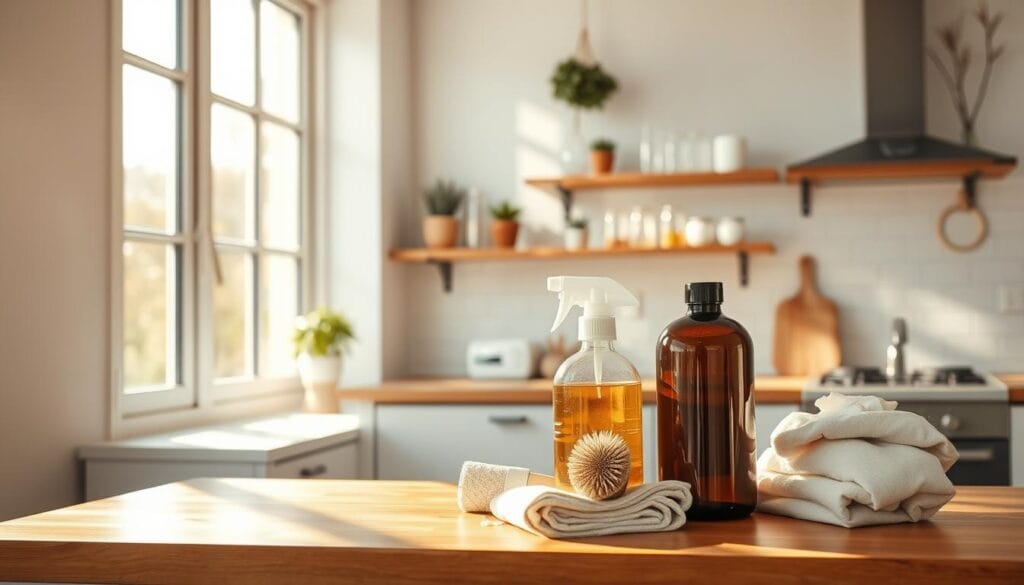
Sustainable Cleaning and Laundry Solutions
Start with your cleaning routine. Swap out single-use products for reusable alternatives. For example, biodegradable laundry sheets are a great way to cut down on plastic waste. Refillable glass spray bottles are another eco-friendly choice that’s both practical and stylish.
Here are a few simple swaps to get started:
- Use bamboo cleaning brushes instead of synthetic ones.
- Choose natural cleaning agents like vinegar and baking soda.
- Opt for reusable cloths over paper towels.
These changes not only simplify your life but also reduce your carbon footprint. As one expert puts it,
“Every small step you take toward sustainable living is a step toward a healthier planet.”
In the laundry room, consider air-drying clothes instead of using a dryer. This simple habit saves energy and extends the life of your clothes. You can also switch to eco-friendly detergents that are free from harmful chemicals.
By making these adjustments, you’re not just decluttering your home—you’re creating a healthier environment for yourself and future generations. Ready to take the next step? Your eco-friendly journey starts today!
Conclusion
Imagine stepping into a space that feels calm and organized. This is the power of simplifying your life and embracing eco-friendly choices. By decluttering, you reduce stress and create room for what truly matters.
Every item you let go of is a step toward a healthier planet. Choosing sustainable purchases lowers your carbon footprint and supports a greener future. Small changes, like swapping single-use products for reusable ones, make a big difference.
Remember, this is a journey. Celebrate every win, no matter how small. Your home will feel more peaceful, and your lifestyle will align with your values. Keep going—your efforts benefit both you and the world around you.

